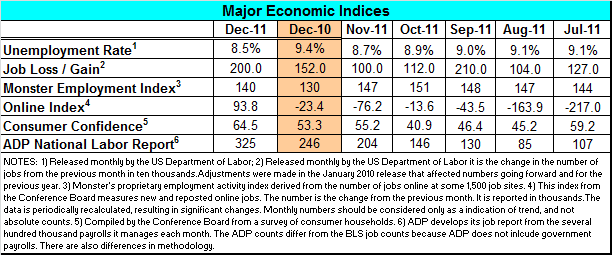Surprising economists and putting an upbeat end to 2011, the U.S. unemployment rate declined to 8.5 percent in December while the economy added 200,000 new non-farm jobs.
It was the fourth consecutive month of declines in the unemployment rate, and the sixth month of six-figure job growth. December’s unemployment rate is the lowest since early 2009.
 The official numbers from the U.S. Department of Labor beat all but the most aggressive estimates. Economists were expecting the unemployment rate to rise, and predicted new job numbers in the 150,000 range.
The official numbers from the U.S. Department of Labor beat all but the most aggressive estimates. Economists were expecting the unemployment rate to rise, and predicted new job numbers in the 150,000 range.
Yesterday, ADP’s monthly employment numbers suggested a January surprise when the company said 325,000 private sector jobs were added in December. Analysts cautioned that the ADP report was not entirely reliable, though they said it pointed in the right direction. This morning’s government report said 212,000 new private sector jobs were added last month.
The U.S. Bureau of Labor Statistics, which compiles and releases the government figures, revised unemployment rates back to January, none by more than .1. November’s initial 8.6 percent was raised to 8.7 percent.
As in the case of the ADP data, seasonal adjustments might be making the jobs numbers somewhat rosier than is actually the case. The New York Times explained that because seasonality takes into account recent year patterns, the drop-off in hiring when the recession began in December 2007 might skew the numbers.
Nonetheless, there is plenty of evidence the economy is continuing to improve. Today’s report said the average workweek for all private, non-farm workers increased to 34.4 hours, while the manufacturing week lengthened to 40.5 hours.
Average hourly earnings rose by 4 cents to $23.24, making the average pay increase for the year 2.1 percent.
“You got the trifecta — more people working, wages up, and the average work week up,” said Stuart Hoffman, chief economist at PNC Financial Services Group Inc. to Bloomberg News. “You can’t really argue that that isn’t a sign of significant improvement in the job market.”
Some of the strongest signs are the 23,000 new manufacturing jobs in December, the first significant improvement in four months for that sector. Mining, largely in the petroleum industry, was up by 7,000. Transportation and warehousing rose by 50,000 thanks in part to strong seasonal hiring during the month.
For the year, the economy added 1.64 million workers; 1.9 million new private sector jobs were created, but government layoffs offset some 280,000. Nevertheless, it was the most jobs created since 2006, and follows the 940,000 increase in 2010.
Still, the economy overall lost 8.75 million jobs in the recession. And even with the declines in the unemployment rate, some 13.1 million workers are out of a job. Another 8.1 million were working part time in December because they couldn’t find full-time jobs. About 2.5 million more are counted as “marginally attached,” a number unchanged in a year. They aren’t included in the official unemployment count because they didn’t look for work during the government’s survey period.
Together, these 23.7 million unemployed and underemployed workers, show there is still a long way to go to get back to pre-recession levels.
